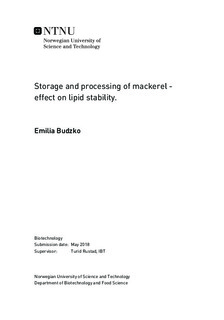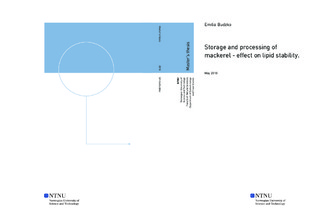| dc.description.abstract | Atlantic mackerel (Scomber scombrus) provides numerous important nutrients linked to lipids, proteins and other bioactive compounds. Mackerel is a very good source of long chain n-3 polyunsaturated fatty acids which have a lot of beneficial health effects, for example on cardiovascular diseases. Unfortunately, due to the high amount of unsaturated fatty acids, mackerel is highly prone to lipid oxidation leading to a decrease of health benefits, while decreasing sensory (undesirable taste and flavor) and nutritional profile. In order to protect
Atlantic mackerel from lipid oxidation during storage a number of preservation/mild processing methods were explored in this project.
The main purpose of the project was to prolong shelf-life and retain sensory quality and nutritional properties of the mackerel including preserving vitamins, minerals, proteins, lipids etc. The aim of this master thesis was to study the effect of different types of storage (chilling, superchilling and freezing) and duration of storage on the oxidation stability in mackerel lipids. The skin-on fillets were chilled for 0, 2, 5 and 7 days; superchilled for 2, 5, 9 and 14 days; and frozen for 2 days, 8 months and one year. Total lipid content, primary and secondary oxidation products were evaluated by assessing the peroxide value (PV) and TBARS (chloroform and water/methanol phase) respectively. Color parameters were measured in order to assess the lightness, redness and yellowness. Additionally, the effects of various sous-vide time - temperature regimes and their influence on lipid oxidation were evaluated during chilled storage. The fillets were cooked in sous-vide bath for 10, 15 and 20 minutes at 60°C, 75°C and 90°C and further stored for 1, 3 and 7 days on ice. Color parameters and formation/accumulation of products of lipid oxidation were measured.
The total lipid content was range between 19,80% and 22,68%. The PV values were well within the recommended limits. None of the samples exceeded 10 meq O2/kg oil and the highest obtained PV was 6,43 meq O2/kg oil for superchilled fish at day 5th. Superchilled samples were in general characterized by slightly higher PV than chilled and frozen. The results from evaluation of secondary oxidation products show low values of TBARS in chloroform phase (maximum TBARS for superchilled mackerel at day 5th was 2,35 μmol TBARS/g lipid), which varies depending on type of storage. TBARS for methanol/water phase slightly decreased during chilled storage, increased during freezing and for superchilled samples the level of TBARS was rather stable. Color measurements revealed a correlation between secondary oxidation products and yellowness what showed that accumulation of secondary oxidation products contribute to yellowness of fish flesh. Superchilling has a potential for prolonging the shelf life of the mackerel products. Even though, the results of peroxide value and TBARS were significantly higher for superchilled fish, they were below the approved by FFA range (10 meq
O2/ kg oil) for human consumption. Optimization of the process and storage conditions of the product is needed in order to retain good quality of the product. Freezing seems to be a better option than prolonged chilled or superchilled storage, because the lipids are relatively stable and shelf life can be extended up to a year.
The analysis of sous-vide cooked mackerel fillets revealed that temperature and time of cooking had rather low influence on the formation of primary and secondary oxidation products. However, PV gradually increased with duration of chilled storage, which leads to the conclusion that storage duration has the largest effect on lipids stability of sous-vide cooked mackerel. Increase in TBARS and yellowness for sous-vide cooked mackerel and significant differences between analyzed mackerel samples show that increase in cooking temperature, time of exposure to heat and duration of chilled storage increase the content of secondary lipid oxidation products. Sous vide cooking is a good option for preparing ready to eat products, because it can prolong the shelf life of the product. It can be also used in catering or restaurants for products that will be heated before serving, however optimal temperature and time of cooking are needed to maintain a high quality. | |

